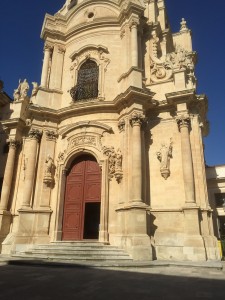
Baroque Cathedral, Ragusa
It was really exciting to learn about other important periods of Sicilian history, such as the explosion of Baroque architecture after the earthquakes of the sixteenth and seventeenth centuries. All of these beautiful little towns had enormous baroque cathedrals that existed so unassumingly in the makeup of the town. They reminded me of the similar function temples must have held in the ancient world. Indeed, both cathedrals and temples seem to hold similar positions in the fabric of the city. Aside from the obvious parallel of religious function, both places of worship are constructed on an incredibly grand scale, likely for the purpose of inspiring awe in the observer/worshipper. Indeed, both the Baroque and Doric architectural styles seem to ascribe to the same principle: if your religious building is beautiful and awe inspiring, your deity which you worship is that much more powerful and worthy of respect. Similarly, it seemed to me that fine architecture was not limited to main urban centers, as one might expect in a modern city with non-religious buildings. Small towns all over Sicily (from modern Ragusa to Modica, from ancient Segesta to Selinunte) were in possession of large, artistic religious buildings where (or near which) worship could take place.
I think this speaks to the significance of religion, both in ancient and modern Sicilian culture. Towns were more likely to spend money on beautifying the edifice of a religious site, rather than on public construction for governmental purposes, etc. Personally, I find this connection in community priorities fascinating and would love to have more time to research and learn about it.